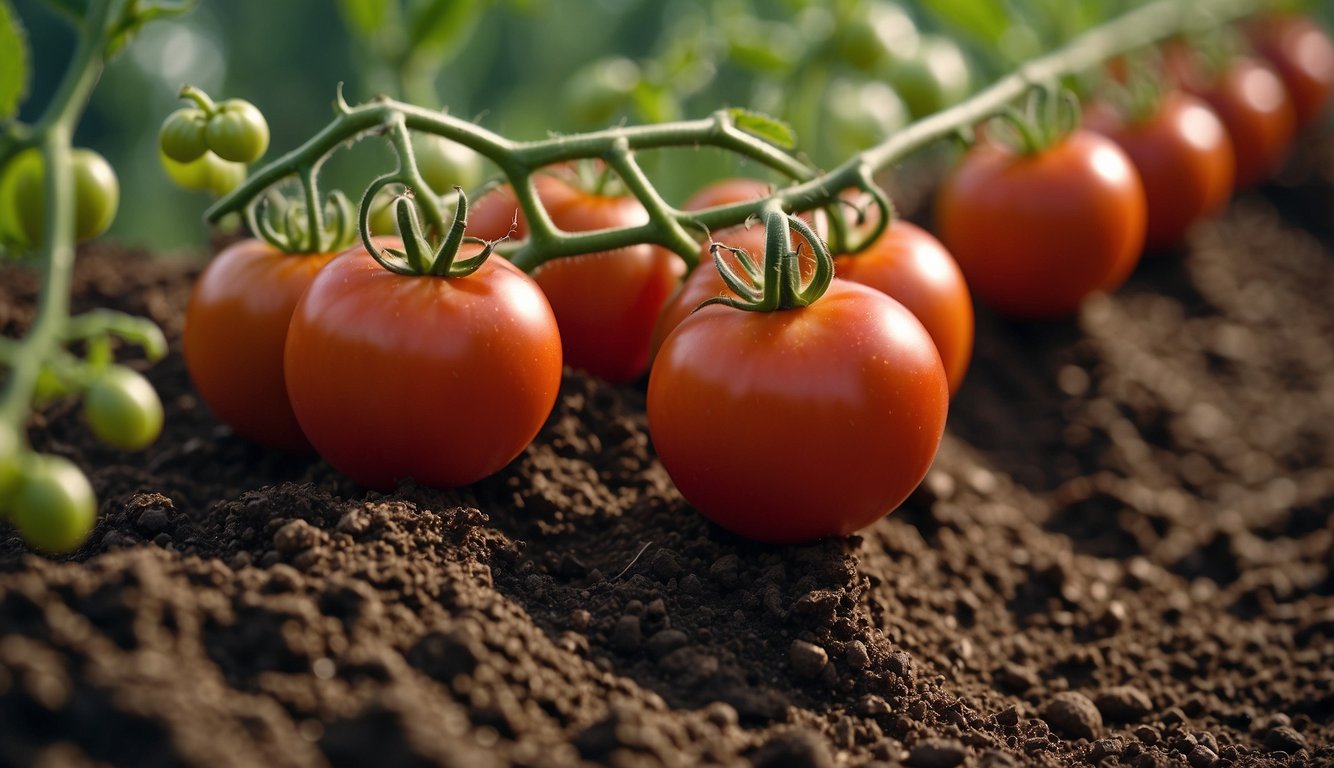TheHerbProf.com is a treasure trove of knowledge for those interested in natural healing and herbal remedies. The website is run by Paul Johnston MD. A naturopathic who has not only received extensive education in the field but also has personal experience in self-healing.
Planting tomatoes sideways is a gardening technique that has gained popularity in recent years. This method involves planting tomato seedlings horizontally in a trench instead of vertically in a hole. The idea behind this technique is to encourage the plant to develop a larger root system, which can result in a healthier and more productive plant.
I have found that planting tomatoes sideways can be an effective way to grow tomatoes, especially in areas with poor soil or limited space. By planting the tomato seedlings horizontally, the stem will develop roots along the buried portion, which can help the plant absorb more nutrients and water from the soil. Additionally, the plant will be less likely to topple over in strong winds or heavy rain, as the larger root system provides better anchorage.
Overall, planting tomatoes sideways can be a great option for gardeners looking to increase their tomato yield and improve plant health. However, it is important to note that this technique may not be suitable for all tomato varieties and growing conditions. It is always best to do your research and consult with a gardening expert before trying out new techniques in your garden.
Benefits of Sideways Tomato Planting – Planting Tomatoes Sideways
As an experienced gardener, I have found that planting tomatoes sideways has many benefits. In this section, I will discuss the advantages of this technique and why it is worth considering.
Enhanced Root Development
One of the main benefits of planting tomatoes sideways is that it promotes enhanced root development. When you plant a tomato plant sideways, the stem will develop adventitious roots along its length. These roots will grow into the soil, creating a stronger, more extensive root system. This system allows the plant to access more water and nutrients, leading to healthier and more robust growth.
Improved Nutrient Uptake
Another advantage of planting tomatoes sideways is that it improves nutrient uptake. With a more extensive root system, the plant can absorb more nutrients from the soil. This increased nutrient uptake results in healthier plants that are more resistant to disease and pests.
Increased Yield Potential
Finally, planting tomatoes sideways can increase the yield potential of your plants. With a more extensive root system and improved nutrient uptake, your plants will be healthier, stronger, and more productive. This increase in yield potential means that you can enjoy a bountiful harvest of delicious tomatoes.
Planting tomatoes sideways offers many benefits, including enhanced root development, improved nutrient uptake, and increased yield potential. By considering this technique, you can help your tomato plants thrive and produce a bountiful harvest.
Preparing the Soil for Planting – Planting Tomatoes Sideways
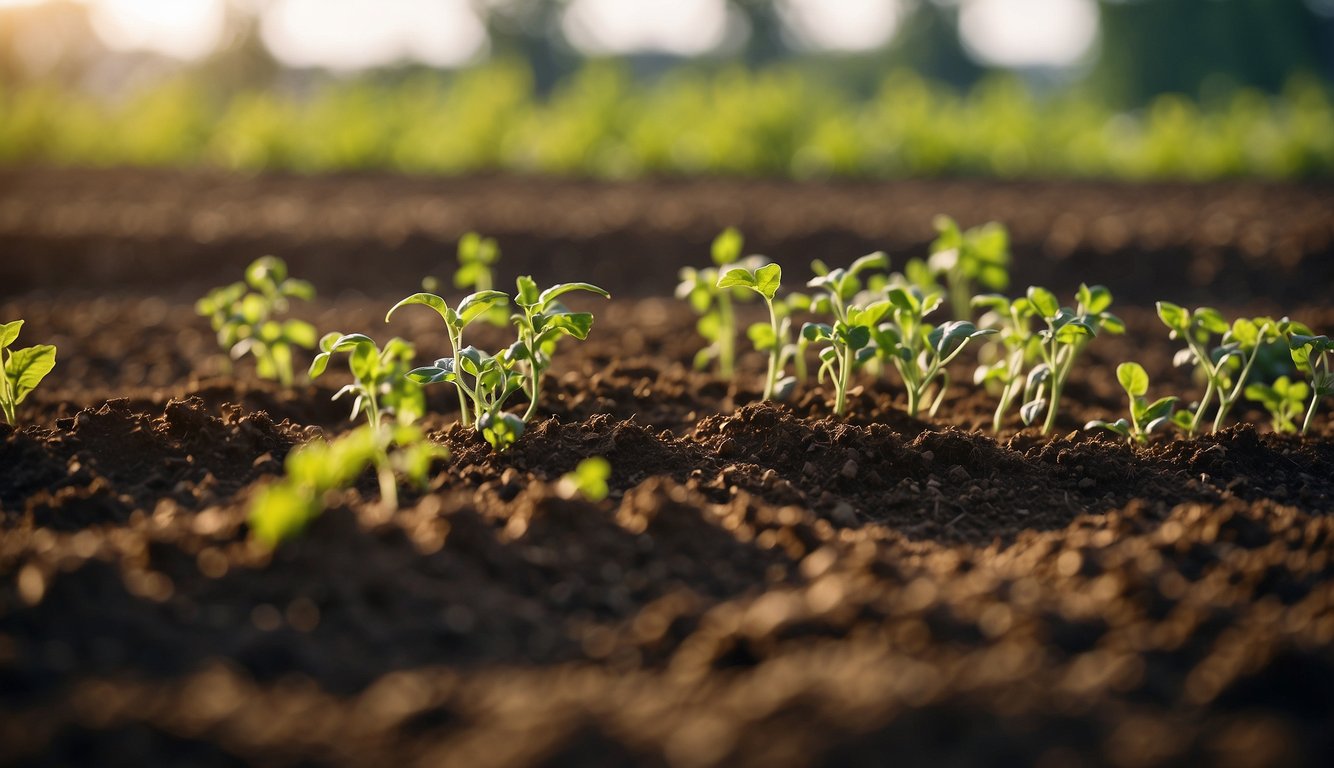
When it comes to planting tomatoes sideways, the quality of the soil is crucial for the success of the plants. In this section, I will discuss the steps to prepare the soil for planting, including selecting the right soil type, soil enrichment with compost, and trench preparation techniques.
Selecting the Right Soil Type
Tomatoes grow best in well-draining soil that is rich in organic matter. The ideal soil pH range for tomatoes is between 6.0 and 7.0. Before planting, it’s important to test the soil pH to ensure that it falls within this range. If the soil pH is too low, add lime to raise it. If it’s too high, add sulfur to lower it.
Soil Enrichment with Compost
Adding compost to the soil is an excellent way to enrich it with nutrients and improve its texture. Compost is a natural fertilizer that provides the essential nutrients that tomatoes need to grow and thrive. It also helps to improve soil structure, which allows for better water retention and drainage.
To enrich the soil with compost, I recommend adding a layer of compost to the topsoil and working it into the soil with a garden fork or tiller. The amount of compost to add depends on the quality of the soil. If the soil is poor, add a thicker layer of compost. If the soil is already rich, a thinner layer will suffice.
Trench Preparation Techniques – Planting Tomatoes Sideways
Trenching is a popular technique for planting tomatoes sideways. To prepare the trench, I recommend digging a trench that is about 6-8 inches deep and 2-3 feet wide. The trench should be deep enough to accommodate the entire root ball of the tomato plant.
After digging the trench, add a layer of compost to the bottom of the trench. This will help to enrich the soil and provide the nutrients that the tomato plants need to grow. Next, add a layer of mulch on top of the compost. The mulch will help to retain moisture in the soil and prevent weeds from growing.
Preparing the soil for planting tomatoes sideways requires selecting the right soil type, enriching the soil with compost, and preparing the trench properly. By following these steps, you can ensure that your tomato plants have the best possible chance of growing and producing a bountiful harvest.
Planting Tomatoes Sideways Step-by-Step
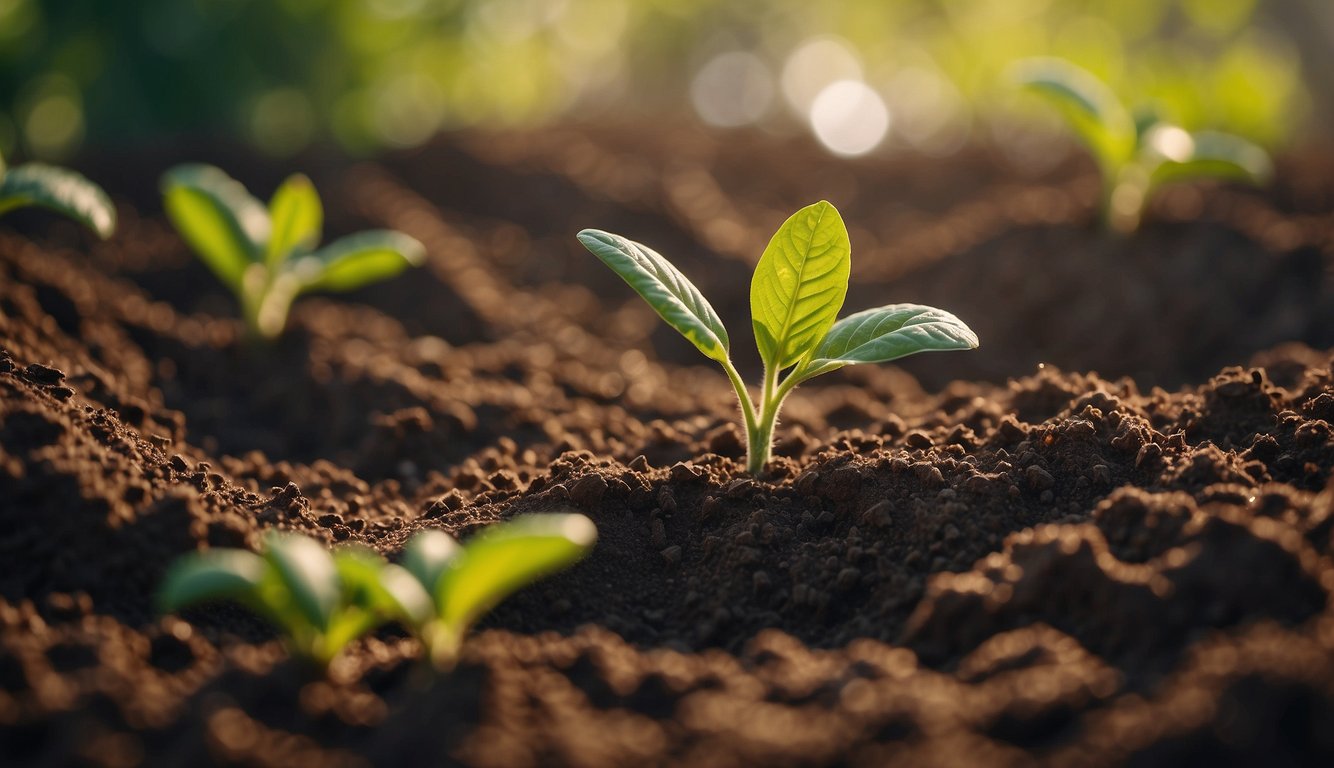
If you want to grow tomatoes, planting them sideways can be a great option. Here’s a step-by-step guide to help you get started.
Digging the Shallow Trench – Planting Tomatoes Sideways
To plant tomatoes sideways, you’ll need to start by digging a shallow trench in the soil. The trench should be approximately 4-6 inches deep and 12-18 inches long. Make sure the trench is wide enough to accommodate the root ball of the tomato plant.
Positioning the Tomato Plant
Once you’ve dug the trench, it’s time to position the tomato plant. Gently remove the plant from its container and carefully loosen the roots. Place the plant in the trench so that the root ball is below the soil and the stem and leaves are above the soil.
Burying the Stem and Root Ball
To finish planting the tomato sideways, you’ll need to bury the stem and root ball. Gently backfill the trench with soil, making sure to cover the stem and root ball completely. You can also use a stake or garden twine to support the plant if necessary.
Remember to water the plant thoroughly after planting, and keep it well-watered throughout the growing season. With a little care and attention, you should be able to enjoy a bountiful harvest of delicious, juicy tomatoes.
This method of planting tomatoes sideways is a great way to encourage strong root growth and increase your yield. By burying the stem and root ball, you’ll create a larger root system that can absorb more nutrients and water, leading to healthier plants and bigger, tastier tomatoes.
Choosing the Right Tomato Varieties – Planting Tomatoes Sideways
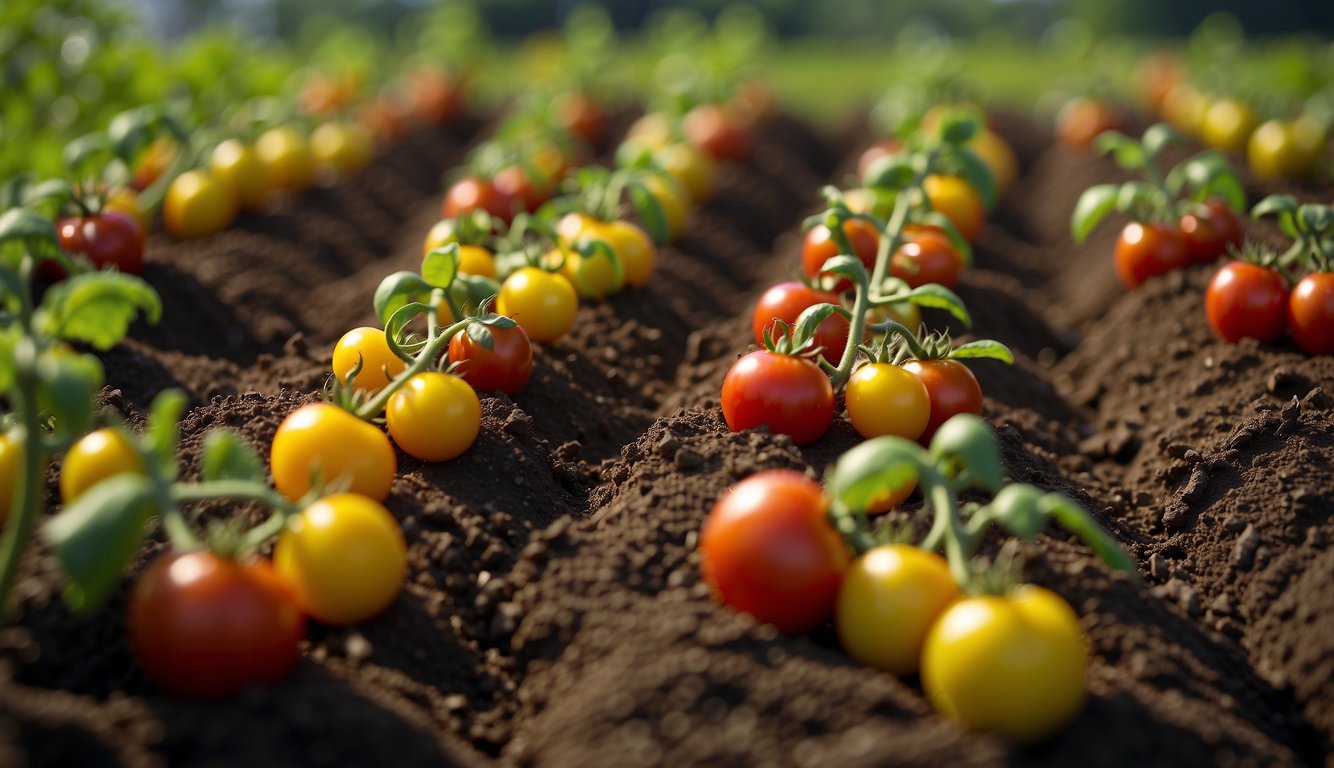
When it comes to planting tomatoes sideways, choosing the right tomato variety is crucial. Here are some factors to consider when selecting the right tomato variety for your garden:
Determinate vs. Indeterminate Tomatoes
Determinate tomatoes grow to a certain height and then stop growing, while indeterminate tomatoes continue to grow and produce fruit until the first frost. If you have limited space, determinate tomatoes are a good choice, as they tend to be more compact and bushy. Indeterminate tomatoes, on the other hand, require more space and support, but they tend to produce more fruit over a longer period of time.
Heirloom versus Hybrid Varieties – Planting Tomatoes Sideways
Heirloom tomatoes are open-pollinated and have been passed down from generation to generation. They tend to have a unique flavor and come in a variety of shapes and colors. Hybrid tomatoes, on the other hand, are the result of crossbreeding two different tomato varieties. They tend to have a higher yield and are more disease-resistant than heirloom varieties.
Selecting for Disease Resistance
Tomato plants are susceptible to a number of diseases, including blight, mosaic virus, and wilt. When selecting tomato varieties, it’s important to choose ones that are resistant to these diseases. Look for varieties that are labeled as disease-resistant, or talk to a local nursery or gardening expert to find out which varieties are best suited for your area.
By considering these factors, you can select the right tomato varieties for your garden and ensure a successful harvest.
Support Systems for Sideways Tomato Plants
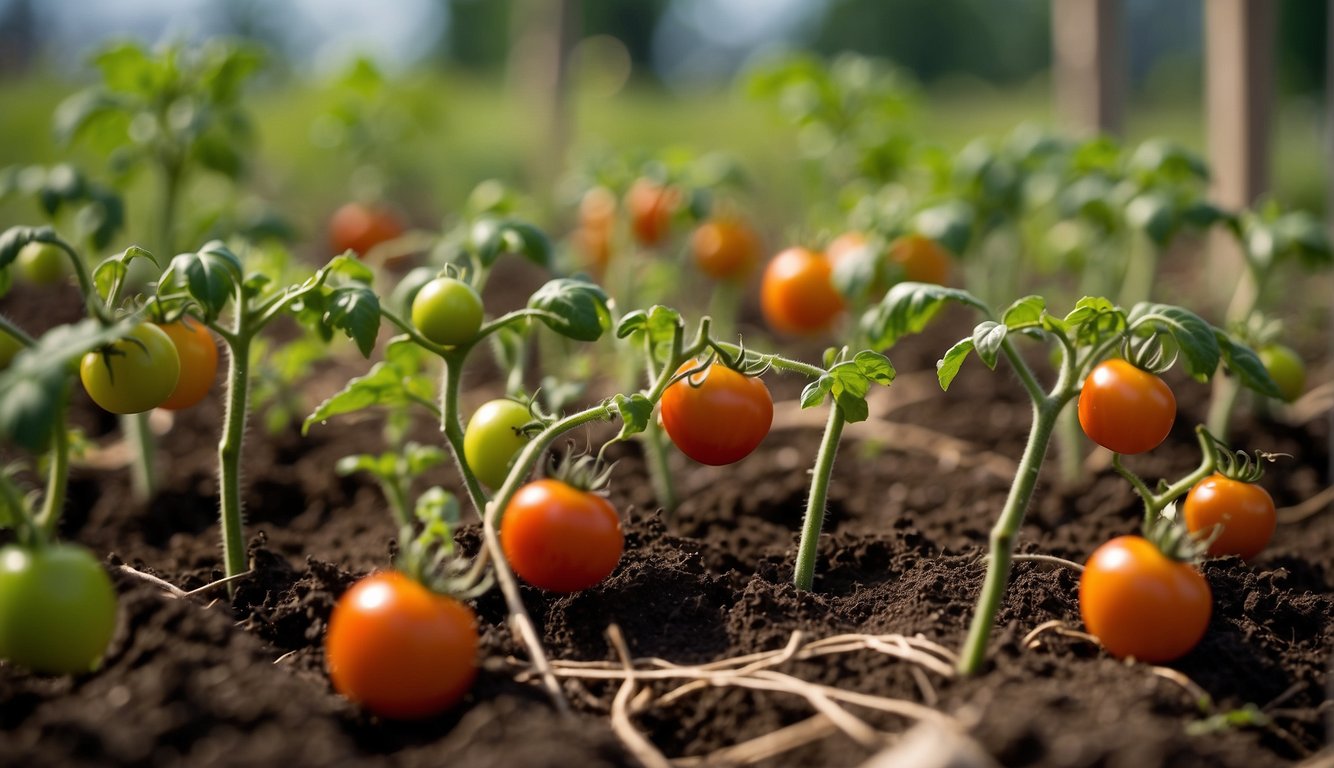
When planting tomatoes sideways, it is important to provide them with the necessary support to prevent the stem from breaking or bending. There are several support systems that can be used for sideways tomato plants, including staking, using cages and trellises, and support for larger container growth.
Staking Methods – Planting Tomatoes Sideways
Staking is a popular support system for tomato plants, especially for those that are grown in small gardens or containers. To stake a sideways tomato plant, insert a sturdy wooden or metal stake into the soil next to the plant and tie the stem loosely to the stake using a soft twine or string. As the plant grows, continue to tie it to the stake at regular intervals to provide support.
Using Cages and Trellises
Cages and trellises are also effective support systems for sideways tomato plants, especially for those that are grown in larger gardens. A tomato cage is a wire frame that surrounds the plant and provides support as it grows. A trellis, on the other hand, is a vertical structure that the plant can climb up as it grows. Both cages and trellises can be used for sideways tomato plants by simply laying the plant on its side and positioning the cage or trellis around it.
Support for Larger Container Growth
For larger container growth, it is important to provide the tomato plant with a sturdy support system that can handle the weight of the plant and its fruit. A large trellis or cage can be used for this purpose, or a wooden or metal stake can be inserted into the soil next to the container and tied to the plant using a soft twine or string.
When planting tomatoes sideways, it is important to provide them with the necessary support to prevent the stem from breaking or bending. Staking, using cages and trellises, and support for larger container growth are all effective support systems that can be used for sideways tomato plants.
Watering and Fertilization – Planting Tomatoes Sideways
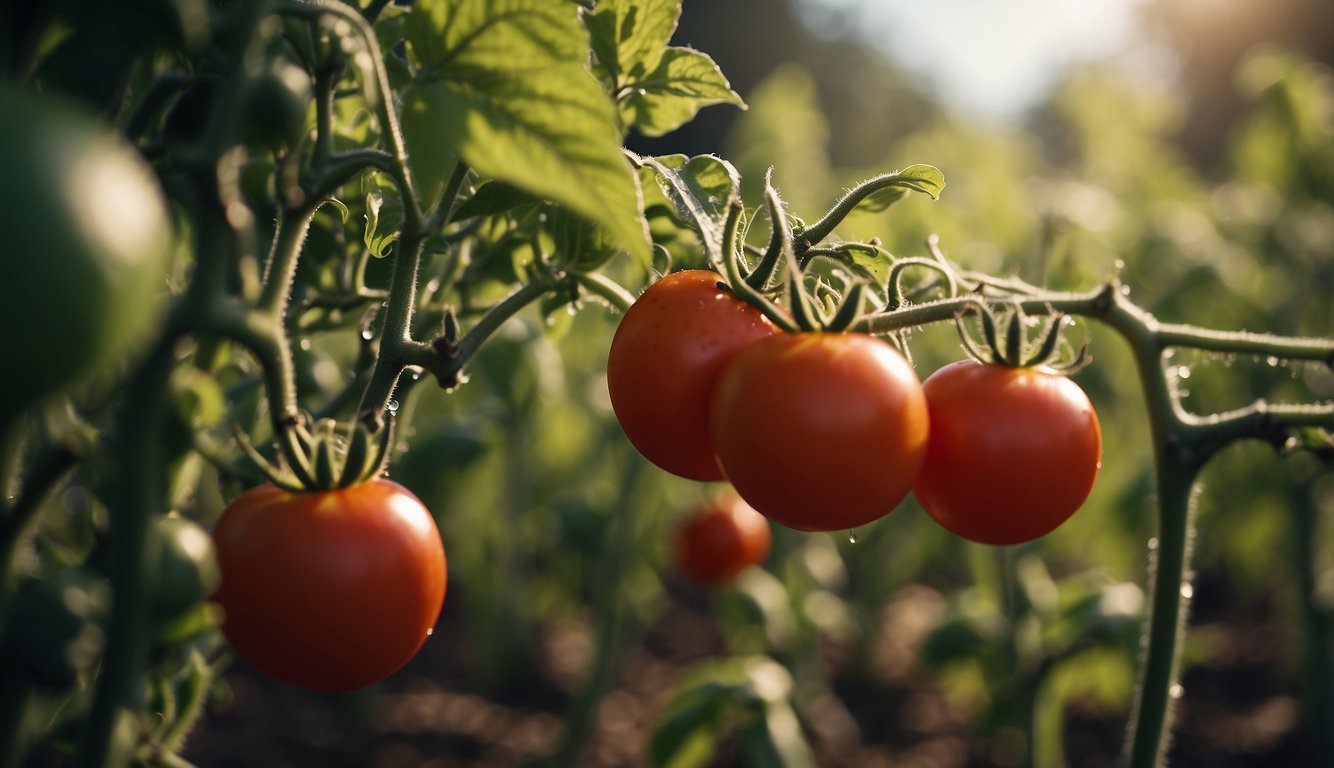
As I mentioned earlier, planting tomatoes sideways can result in a stronger root system and a healthier plant. However, proper watering and fertilization are also essential for optimal growth.
Irrigation Strategies
Tomatoes require consistent moisture throughout the growing season. Overhead watering can lead to fungal diseases, so it’s best to water at the base of the plant. A drip irrigation system or soaker hose is a great way to ensure even moisture distribution.
I prefer to water my tomatoes deeply once or twice a week, rather than giving them a little bit of water every day. This encourages the roots to grow deeper into the soil in search of moisture. However, be careful not to overwater, as this can lead to root rot.
Applying Fertilizers for Optimal Growth
Tomatoes are heavy feeders and require regular fertilization throughout the growing season. Before planting, I like to amend the soil with compost to provide a slow-release source of nutrients.
Once the plants are established, I apply a balanced fertilizer every 4-6 weeks. Alternatively, you can use a slow-release fertilizer at the beginning of the season. Be sure to follow the manufacturer’s instructions for application rates.
It’s important not to over-fertilize, as this can lead to excessive vegetative growth at the expense of fruit production. Additionally, avoid getting fertilizer on the leaves or stems, as this can burn the plant.
By following these irrigation and fertilization strategies, you can ensure that your sideways-planted tomatoes have all the water and nutrients they need for optimal growth and a bountiful harvest.
Managing Pests and Diseases – Planting Tomatoes Sideways
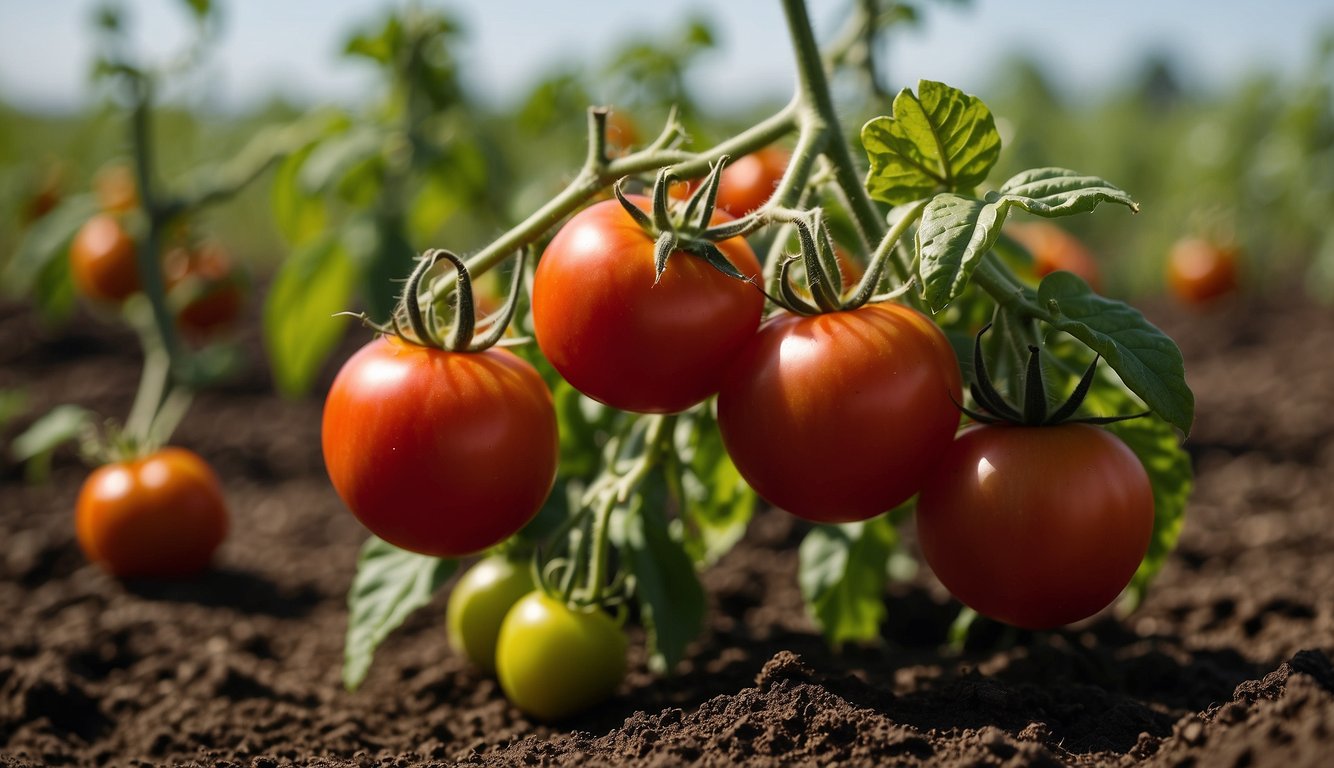
As a tomato gardener, managing pests and diseases is crucial for a successful harvest. Here are some tips on how to identify common tomato pests and prevent and treat diseases.
Identifying Common Tomato Pests – Planting Tomatoes Sideways
There are several common pests that can attack tomato plants, including aphids, whiteflies, and hornworms. Aphids are small, soft-bodied insects that suck the sap from tomato plants, causing leaves to curl and turn yellow. Whiteflies are tiny, winged insects that feed on the underside of leaves, causing leaves to yellow and drop prematurely. Hornworms are large, green caterpillars that can quickly defoliate a tomato plant.
To identify these pests, look for signs of damage on the leaves and stems of your tomato plants. You may also see the pests themselves on the plant. If you suspect an infestation, take action immediately to prevent further damage.
Preventing and Treating Diseases
Tomato plants are also susceptible to several diseases, including blight, wilt, and mosaic virus. Blight is a fungal disease that causes leaves to turn brown and die. Wilt is a bacterial disease that causes the plant to wilt and die. Mosaic virus is a viral disease that causes mottled leaves and stunted growth.
To prevent diseases, it’s important to keep your tomato plants healthy and stress-free. This includes providing adequate water and nutrients, as well as proper spacing and pruning.
If you do notice signs of disease, it’s important to act quickly to prevent it from spreading. This may include removing infected plants, using fungicides or bactericides, or using resistant varieties.
By identifying common tomato pests and preventing and treating diseases, you can help ensure a healthy and productive tomato harvest.
Pruning and Maintenance – Planting Tomatoes Sideways
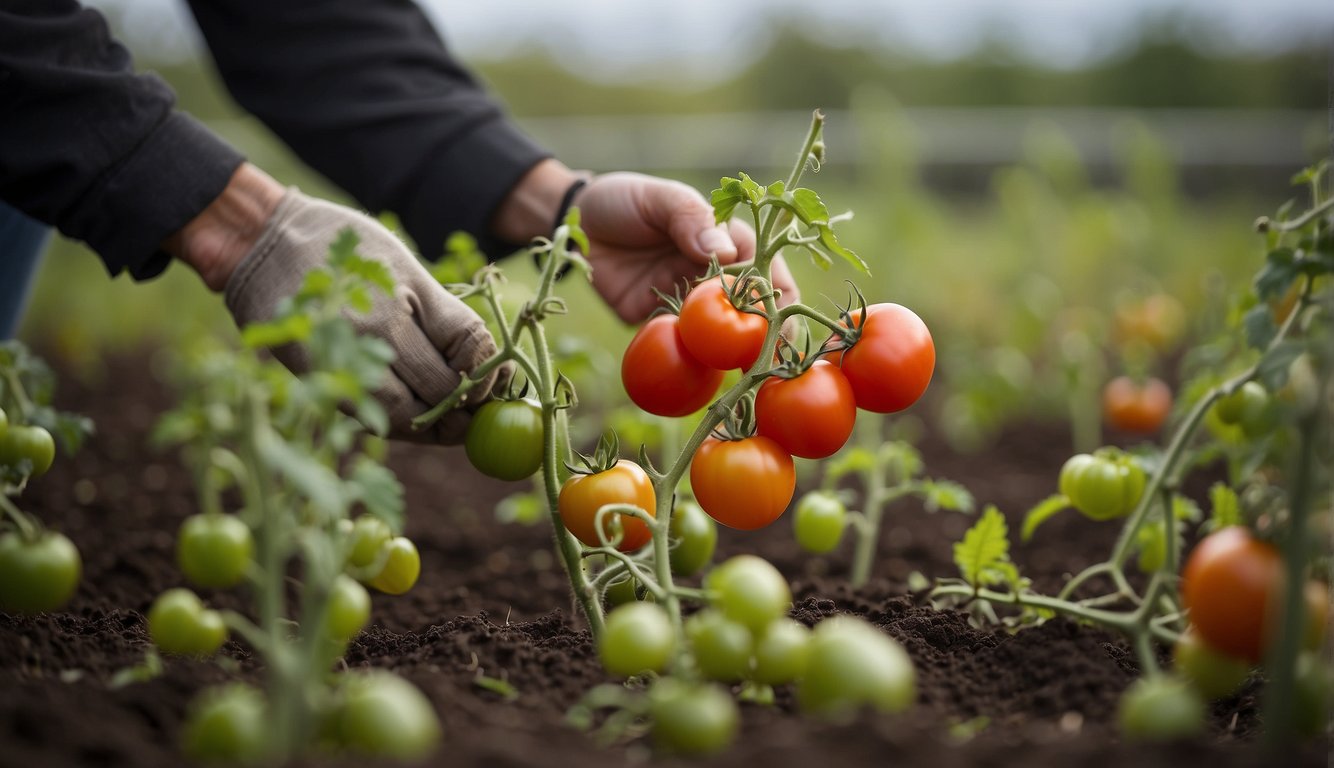
Planting Tomatoes Sideways – Pruning for Healthier Plants
Pruning is an essential part of maintaining healthy tomato plants. It helps in removing diseased or damaged foliage, promoting air circulation, and improving the overall health of the plant. I recommend pruning tomato seedlings when they are about 6-8 inches tall. At this point, they should have at least two sets of true leaves.
To prune, I start by removing the lower leaves that are touching the ground. These leaves are more susceptible to diseases and pests. Next, I remove any suckers that form between the stem and branches. Suckers are small shoots that grow in the crotch between the main stem and the side branches. They can drain the plant’s energy and reduce the yield.
Ongoing Plant Care
After pruning, ongoing plant care is crucial for the health and productivity of the tomato plants. I recommend watering the plants deeply and regularly, especially during hot and dry weather. It’s best to water the plants at the base, rather than from above, to avoid wetting the foliage.
Fertilizing is also important for the growth and yield of tomato plants. I recommend using a balanced vegetable fertilizer, following the instructions on the package. Over-fertilization can lead to excessive foliage growth and reduced fruit production.
Regularly inspecting the plants for pests and diseases is also essential. Early detection and treatment can prevent the spread of problems and reduce damage. I recommend removing any diseased or damaged foliage promptly to prevent the spread of diseases.
Pruning and ongoing care are crucial for maintaining healthy and productive tomato plants. By following these simple steps, you can enjoy a bountiful harvest of delicious vegetables.
Harvesting and Storage – Planting Tomatoes Sideways
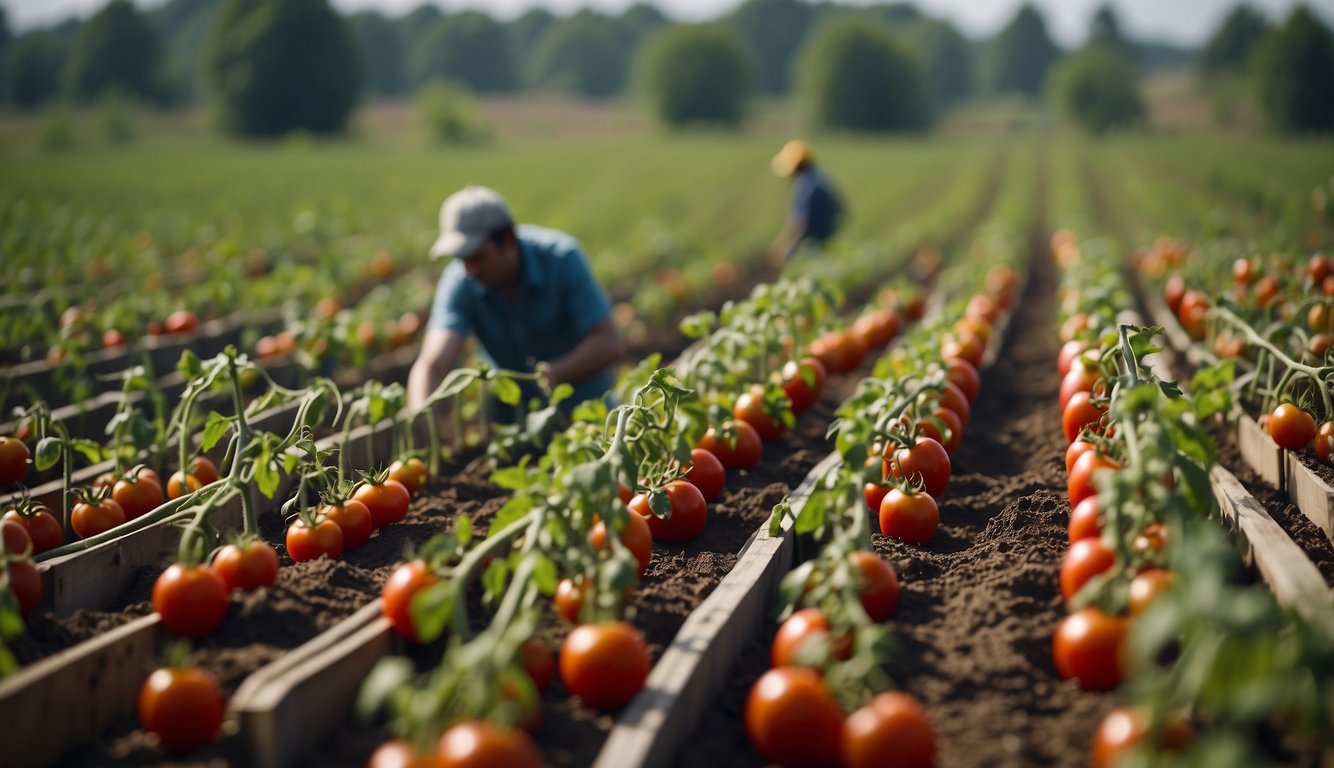
Picking Tomatoes at Peak Ripeness
When it comes to harvesting tomatoes, timing is everything. You want to pick them at the peak of ripeness for the best flavor and texture. Look for fruits that are fully colored and slightly soft to the touch. Avoid tomatoes that are still green or have any signs of decay or damage.
To pick the fruit, gently twist it off the vine or use a pair of pruning shears to cut the stem about half an inch above the tomato. Be careful not to damage the plant or any surrounding fruits.
If you have a bumper crop of tomatoes, you may need to harvest them in stages as they ripen. Late-ripening varieties can be left on the vine longer, but keep an eye on them to avoid over-ripening or rotting.
Storing Tomatoes for Longevity
Proper storage is key to keeping your tomatoes fresh and flavorful for as long as possible. If you have a small number of tomatoes, you can store them on the counter at room temperature, away from direct sunlight. Be sure to use them within a few days.
For larger quantities, consider storing them in the refrigerator. This will slow down the ripening process and extend their shelf life. However, refrigeration can also affect the texture and flavor of the fruit, so it’s best to use them within a week.
Another option is to can or freeze your tomatoes for long-term storage. Canning involves boiling the tomatoes in jars with added acid, while freezing involves blanching the fruit and storing it in freezer-safe containers. Both methods require some preparation and equipment, but they can be a great way to enjoy your tomato harvest year-round.
Overall, proper harvesting and storage techniques are essential for getting the most out of your tomato growing experience. With a little care and attention, you can enjoy a bountiful harvest of delicious, juicy fruit.
Planting Tomatoes Sideways and Its Connection with TheHerbProf.com
Today, we’re digging into the world of Planting Tomatoes Sideways. This unconventional method can lead to stronger, healthier plants!
First up, The Method. Planting tomatoes sideways involves laying the plant on its side in a trench, with only the top leaves exposed. And guess what? TheHerbProf.com has a detailed guide on unique planting methods. It’s like having a personal tomato tutor!
Next, the Benefits. This method encourages a strong root system, as the buried stem will develop additional roots. And TheHerbProf.com? It’s got all the info you need to grow robust tomatoes. It’s a gardener’s dream!
Then there’s the Considerations. Not all tomato varieties are suitable for this method. But with TheHerbProf.com, you’ve got a guide to choosing the right tomato variety for your garden. It’s like a DIY project for your garden!
In short, Planting Tomatoes Sideways and TheHerbProf.com are a match made in garden heaven. They offer a blend of practical gardening advice and fascinating plant facts. So, whether you’re a tomato enthusiast or a curious visitor, there’s always something new to learn!
Remember, folks, sometimes the best path isn’t always straight. Keep exploring TheHerbProf.com for more tomato adventures!
References – Planting Tomatoes Sideways
Little Herb Encyclopedia, by Jack Ritchason; N.D., Woodland Publishing Incorporated, 1995
The Ultimate Healing System, Course Manual, Copyright 1985, Don Lepore
Planetary Herbology, Michael Tierra, C.A., N.D., Lotus Press, 1988
Handbook of Medicinal Herbs, by James A. Duke, Pub. CRP Second Edition 2007
The Complete Medicinal Herbal, by Penelope Ody, Published by Dorling Kindersley
Check the Following Articles!
Can You Eat Beautyberry? A Comprehensive Guide
Rampp-Team.com Is Now Part Of TheHerbProf.com
Where Do Brussels Sprouts Grow Best?
Winter Greenhouse DIY: Tips for Building Your One
Frequently Asked Questions – Planting Tomatoes Sideways
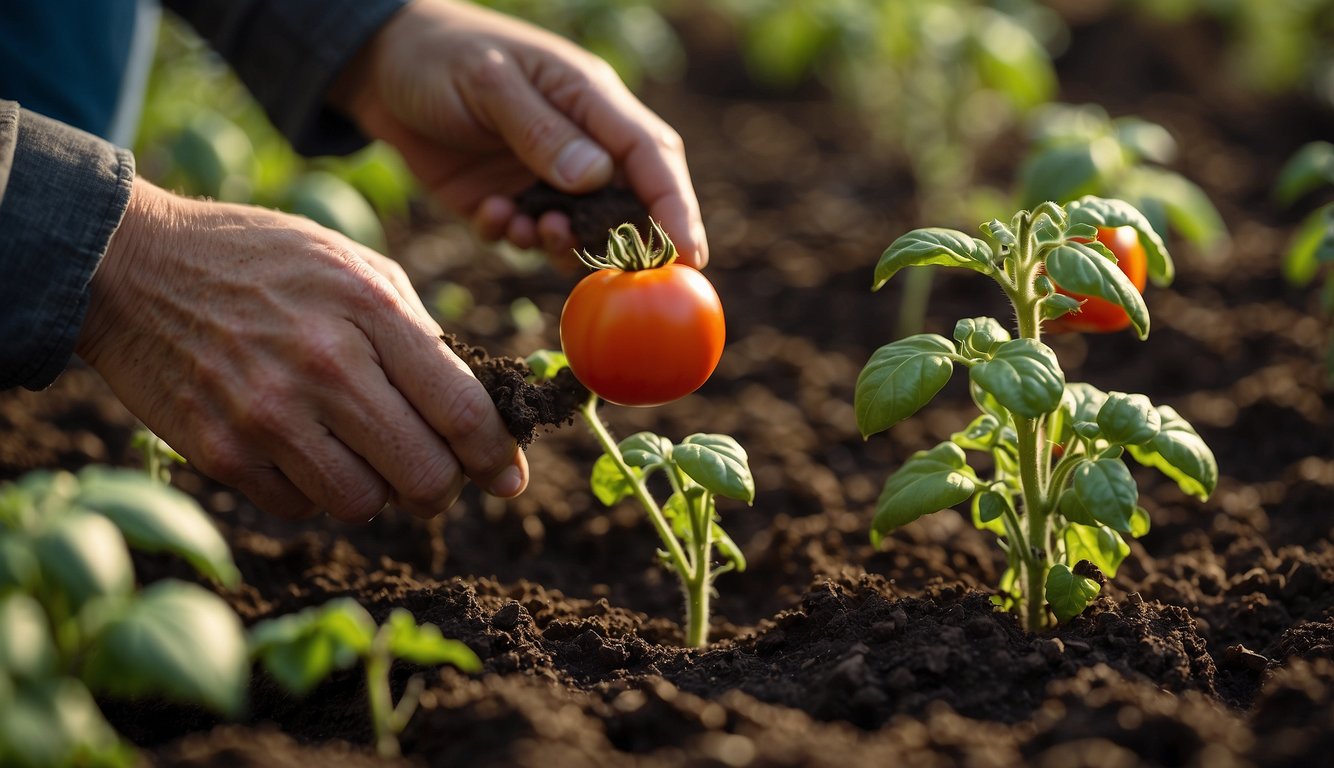
What are the benefits of planting tomato plants deep in the soil?
Planting tomato plants deep in the soil has several benefits. First, it encourages the growth of a stronger root system, which can help the plant to better absorb nutrients and water from the soil. Second, it helps to stabilize the plant, making it less likely to tip over in high winds or heavy rain. Finally, burying the stem of the plant can stimulate the growth of additional roots, which can lead to a larger, healthier plant.
How should tomato seedlings be fertilized for optimal growth?
Tomato seedlings should be fertilized with a balanced, water-soluble fertilizer that is high in phosphorus and potassium. Fertilizer should be applied every two weeks, starting two weeks after the seedlings have been transplanted into the soil. It is important not to over-fertilize, as this can lead to excessive foliage growth at the expense of fruit production.
What is the proper way to use a trellis for growing tomatoes horizontally?
When using a trellis for growing tomatoes horizontally, the trellis should be placed at a height of approximately 6-8 inches above the ground. The tomato plant should be trained to grow along the trellis, with the main stem tied to the trellis using soft twine or garden tape. As the plant grows, additional stems should be tied to the trellis to keep them from sprawling on the ground.
Can tomato plants successfully grow while lying down, and if so, how?
Tomato plants can be grown while lying down, a technique known as “sideways planting.” To plant tomatoes sideways, dig a trench that is approximately 4-6 inches deep and 12-18 inches long. Place the tomato plant in the trench so that the root ball is below the soil and the stem and leaves are above the soil. As the plant grows, additional soil can be added to the trench to encourage the growth of additional roots.
What considerations should be made when planting tomatoes in pots versus in the ground?
When planting tomatoes in pots, it is important to choose a pot that is large enough to accommodate the plant’s root system. The pot should also have adequate drainage holes to prevent water from accumulating at the bottom of the pot. In addition, potted plants may require more frequent watering than plants grown in the ground. When planting tomatoes in the ground, it is important to choose a location that receives at least 6 hours of sunlight per day and has well-draining soil.
For a beginner, what are the essential tips for starting a tomato garden?
For a beginner, starting a tomato garden can be a fun and rewarding experience. Here are a few essential tips to get started:
- Choose a location that receives at least 6 hours of sunlight per day.
- Test the soil to determine its pH level and nutrient content.
- Choose a variety of tomato that is well-suited to your climate and growing conditions.
- Start tomato seedlings indoors 6-8 weeks before the last frost date in your area.
- Transplant seedlings into the ground or larger pots once they have developed their second set of leaves.
- Water tomato plants regularly, but be careful not to over-water.
- Fertilize tomato plants every two weeks with a balanced, water-soluble fertilizer.
- Monitor tomato plants for signs of pests or disease and take action promptly if necessary.
